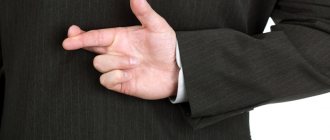It is more convenient to analyze gestures from larger ones (turning and tilting the head and body, arms as barriers; direction of toes and crossing of legs) to small ones (facial expressions, palms, hand to head, fingers). It is believed that body parts located closer to the head are more likely to give false information and express simulated emotions due to the fact that they are easier to consciously control. Parts of the body further away from the head are more likely to express actual emotions and attitudes.
When analyzing gestures, the following is recommended:
- take into account the combination of gestures, since the meanings of some gestures can be strengthened or weakened by others (hence their different interpretations). By the sequence of gestures, you can trace what tendency is observed in a person - whether he opens or closes, whether the gestures contradict each other.
- take into account the context of the situation, external conditions - how they can influence nonverbalism, what it is aimed at.
- compare gestures with what the person says: are there any contradictions.
- by noting at what moment a person makes gestures (listens, thinks, speaks out, and also after what elements of the message - main or secondary), one can approximately judge the importance of arguments for him and how the calculation process occurs in him;
- you should strive to ensure that your communication partner is clearly visible and sits on a non-swivel chair without armrests;
- The technique of gestures allows you not only to diagnose, but also to change the state and attitude of your partner, and to build your behavior in accordance with the behavior of others.
You can change your partner’s state and attitude by changing his posture and gestures.
To do this, you can encroach on his territory by changing the communication distance; rise higher (standing) and lower lower (sitting), give him an object, ask him to bend over, show something to the side or further away from him, come from the side, from behind, etc. Another way is to demonstrate your openness: slightly tilt your head in side, smile, eye contact for two-thirds of the time of communication, open palms, etc.
The measured use of dominant, aggressive and sexual gestures helps to build up the partner and can revive fading contact and increase influence.
Knowing the meaning of gestures and poses, you can partially control your state by simply performing those that are needed. For example, by feigning confidence, it can be acquired internally.
The distance between people communicating can show how much people want to contact each other. Approaching you indicates that this person wants to contact you. However, with such a rapprochement, one should take into account the presence of people’s “intimate zone”, the invasion of which by strangers causes them discomfort, the release of adrenaline, an increase in heart rate, a rush of blood to the head and muscles, i.e. changes in the body aimed at preparing for escape or fight back.
Police interrogating criminals deliberately violate personal boundaries in order to break their resistance. Managers can use this technique to obtain information from their subordinates. At the same time, using this technique when contacting clients is a grave mistake.
The more intimate the relationship between people, the closer they can get to each other without fear of invading the other's personal space. On the other hand, colleagues keep a new employee at a distance (in the business area) until they get to know him better. As employees get to know him better, this distance decreases.
History of the research issue
Psychology has been interested in body gestures for a long time (back in the days of Ancient Rome). This issue was even separated into a separate science called kinesics (later it was divided into narrower areas of knowledge). The following researchers made the greatest contribution to the development of this area:
- J. Balwer wrote a book on body language and gestures in psychology in 1644. The scientist paid special attention to the language of his hands. He concluded that it is a natural language, in contrast to the verbal method of communication, which was invented artificially.
- Pastor I. Caspar Lavater wrote an “Essay on Physiognomy” in 1792, which is considered to be the first systematic study of bodily movements. The work similarly describes the correspondence of a person’s personal properties to the expression of his face and body configuration.
- The German scientist G. K. Lichtenberg published a book in 1765 in which he criticized Lavater's work. He considered his understanding of physiognomy too simplified and far from the real practical activities of man.
- The artist, surgeon and neuroscientist C. Bell was particularly interested in the expressions of the human face, depending on different emotions. In 1844, as a result of many years of research into the nervous system, he concluded that any emotional fluctuations are accompanied by changes in respiratory and muscular activity.
- C. Darwin and E. Kretschmer in 1920 studied the connections between a person’s character and physique, as well as between a person’s emotions and facial expressions.
- D. Bonifacio, F. Bacon and D. Batista della Porta published treatises in 1616 in which they expressed the opinion that there is a universal body language that is understandable to absolutely all peoples of the world.
Among modern works on a given topic, Alexander Lowen’s book “Psychology of the Body” is popular. Bioenergetic analysis of the body." This work focuses on the study of psychosomatics and solving psychosomatic problems.
Similarities and differences between verbal and nonverbal communication
In psychology, body language and gestures have a number of similar characteristics. Here are the main ones:
- Any verbal and non-verbal element can take on contextual meaning depending on the culture of the area.
- In some cases, the meaning of what is planned can be conveyed either only in words or only in gestures.
- Both gestures and verbal units are symbolic signs that form the basis of the lexicon.
- Like linguistic units of different countries, gestures can also be translated and interpreted to suit specific conditions.
- Like natural language, gestures can vary across space and time, depending on economic and cultural conditions.
But there are also fundamental differences. Namely:
- Natural languages consist of relatively stable units, but body language tends to undergo changes.
- Linguistic means of communication have a much greater number of possibilities for describing ideas, phenomena, situations, and objects.
- Gestures are demonstrative in nature and are perceived by the visual apparatus. Language tools are more meaningful.
Key body segments
One of the founders of the psychology of body movements, Wilhelm Reich, conditionally divided the body into 7 segments, muscle contractions in which represent the corresponding problems:
- The eye segment is fears associated with human relationships (conflicts, grievances, evaluations, and so on).
- Oral segment—difficulty expressing feelings and emotions verbally.
- The cervical segment is the containment of anger and aggression.
- Thoracic segment - suppression of positive and negative emotions, experiences and desires, self-control, inability to express feelings.
- Diaphragmatic segment - suppression of anxiety or satisfaction, problems of willpower.
- Abdominal segment - suppression of fear of danger and anger.
- Pelvic segment - suppression of feelings caused by the instinct of self-preservation, blocking intimate stimulation.
The meaning of facial expressions
Human facial expressions are the movement and behavior of facial muscles. She is able to show a person’s thoughts and emotions without the use of speech. Dozens of muscles and fibers are concentrated around the human skull and jaw, which cannot be subordinated to the will, and even with great effort they can betray any mood.
You can “read” a great variety of emotions from your facial muscles: joy, surprise, complacency, fatigue, or a sly squint.
Gestures of sincerity and openness
Knowing the psychology of the body will help you understand how a person is disposed towards you, whether he is inclined to talk. Here are some gestures that symbolize sincerity, openness and benevolence:
- A person actively gestures, holding his hands in front of him, palms up.
- A person tries to reduce the distance during a conversation (sits closer or tries to establish tactile contact).
- An unbuttoned jacket is a symbol of openness and trust in business negotiations. A slightly loose tie knot has a similar meaning.
- Legs straightened and extended forward (if the interlocutors are communicating while sitting).
- Smile all over your face. If the eyes narrow and the nostrils widen, it means that the person is sincerely glad to see you and is committed to productive communication.
- A deep sigh of relief. Having noticed such a gesture, you can be sure that your conversation with the interlocutor will be easy and confidential.
Respect
For a man, there is the easiest and most reliable way to find out how the interlocutor treats him - a handshake. A person who respects you will be the first to extend his hand to greet you. If he does this without much desire or with a delay, he rather treats you somewhat arrogantly. The duration of the handshake, as well as the angle between the hands, also matters: people who respect each other do not try to quickly release their hand, and also keep their hands straight.
The look of a person who respects you is open, the smile is sincere. He often glances in your direction, and if he is looking for your approval, he will look away when your views intersect.
Closed gestures
Knowing the psychology of the body will help you understand that a person is tense and not in the mood to communicate. When a person is scared, feels discomfort or hostility towards the interlocutor, he, without realizing it, begins to “defend”. This is manifested through such gestures:
- Arms crossed on chest. This is a demonstration of self-doubt or a hostile attitude towards the interlocutor.
- Crossed legs (or cross-legged pose). It can indicate mistrust, and when combined with crossed arms, the meaning doubles. It is worth noting that many people find this position comfortable. But in a business conversation, it is better to avoid this pose, since the interlocutor may interpret it incorrectly.
- Hands pressed to the body or lying on the knees are an incomplete barrier. The pose demonstrates distrust or a negative attitude towards the interlocutor.
- Manipulation with things. If a person is constantly twirling a pen in his hands, holding a notepad, or clutching his bag, it means that he is trying to protect himself from you.
- Cringing. Arms pressed tightly to the body, legs closed, hunched shoulders - all these are signs that a person is trying to protect himself from you.
- Hands in pockets. This is a sign of detachment from the interlocutor.
How does the behavior of a lying person manifest itself?
- Often, after telling a lie, the following gestures are observed - loosening a tie, touching the neck, nose, covering the mouth. They often hide their hands during a conversation and may fidget or sway, which indicates anxiety. The opposite behavior also happens - they stand motionless, as if petrified, without showing emotions. They gesture a little, because the brain is busy inventing and controlling the telling of the story.
- Position of the legs - they can swing their legs, showing nervousness, impatience, often the legs are facing in the other direction from the interlocutor. They can make sudden movements with their shoulders, touch the interlocutor, trying to “earn their way into trust.”
- Facial expressions - they hide their gaze, look in the other direction, have a darting gaze, or vice versa do not avert their gaze, look straight at them. The smile is usually strained, unnatural, only movement of the lips, and no changes are visible in the corners of the eyes. Frequent blinking also expresses nervousness or a desire to hide information or feelings.
- Speech - usually spoken in a calm tone, giving meaning to words. They may raise their tone when they are bragging or in an excited state. Usually, a change in the tone of speech does not happen by accident; watch the tone and words. They may stammer, “moo,” make other sounds, and lose their thoughts.
Exposing Lies
Body psychology is a powerful tool for exposing lies. You can tell that a person is being dishonest with you by the following signs:
- Touching any part of the face (mouth, nose, eyelids, cheeks, chin, etc.). When a person tells a lie, his hands subconsciously reach towards his face, as if trying to hide from shame.
- If a person scratches his eyelid, it means that he knows the truth, but is trying to hide it from you.
- Stroking or scratching the neck may mean that the person disagrees with your statement. But for certain reasons (for example, social status), he is afraid to admit it.
- If a person touches his earlobe, it means that he does not believe at all what you are telling him. But, again, he tries not to show it.
- If, before answering your question, a person looks away or begins to look into the distance, this means that he is trying to come up with some kind of lie.
- A smile with just your lips. If all other facial muscles remain motionless, it means the person is insincere with you.
- A sharp change in the pace of speech. If a person slows down or speeds up, it means that at that moment he is telling you a lie.
- Asymmetry of facial expressions and gestures. If only one side is working, or there is dissonance between the parties, then the person is insincere. Although, sometimes this may be due to anatomical features.
Behavior during provocations
Increased breathing, heaving of the chest, frequent swallowing, protruding perspiration - these are signs of strong feelings. It is possible that they are lying to you. Blushing is a sign of embarrassment, but you can also become embarrassed from shame for lying.
Do you like field hockey?
If you try to abruptly change the subject, the person telling the lie will take it with relief and support your initiative, because he understands that the less you talk to him, the less chance he has of “messing up” and giving himself away.
If the interlocutor is sincere, then his natural reaction will be a misunderstanding of the reason for the change of topic, dissatisfaction that his story was not heard to the end. He will try to return to the topic of conversation. I don’t like you guys...
If you have doubts about the veracity of the interlocutor’s words, MirSovetov advises to implicitly show that you do not believe the interlocutor’s story: after his answer to the next question, pause, look closely, with distrust. If they are not honest with you, it will cause embarrassment and uncertainty. If a person tells the truth, then he often begins to get irritated and stare at you. The following changes can be noted in it: embarrassment disappears, lips compress, eyebrows frown.
Gestures of aggression
All human emotions are certainly reflected in human gestures - such is psychology. Body language demonstrates an aggressive attitude as follows:
- Rivers clenched into a fist. This happens involuntarily when a person tries to restrain himself from openly displaying aggression.
- Hands rest with fists on sides. This is a more aggressive gesture, demonstrating readiness to attack the enemy.
- Sitting astride a chair. Reflects a hostile attitude towards the interlocutor, accompanied by a feeling of superiority.
- Hands clasped behind the back. This is an attempt to hide a negative attitude.
- Clenched teeth and lips. A sign of irritability and anger.
- “Chopping” the air or surface with the palm of your hand. This indicates a readiness for open confrontation.
- Stroking or scratching the back of the neck. Feeling threatened and ready to defend.
Gestures of boredom
Body gestures in psychology personify almost all emotions and moods. In particular, it is important for a person to know the signs by which one can determine that a person is bored, that he is not interested in you, that it is time to end the conversation:
- If a person rests his chin or cheek on his hand, it means that he is tired of your chatter and, most likely, he has already lost the thread of the story.
- Tapping your foot on the floor or your fingers on the table is a sign of boredom and impatience. Your interlocutor wants to end the conversation as soon as possible.
- Extraneous activities (for example, drawing curls on paper) are a sign that a person is immersed in his own thoughts and is completely out of your attention.
- Glancing at the door or at the clock is a subconscious demonstration that the conversation has dragged on.
- Intense head nods are the interlocutor’s desire to speed up the conversation in order to come to a logical conclusion.
Hidden consent
Very often, people internally agree with what you say, but in conversation they continue to defend their point of view. This can happen for various reasons: perhaps they are trying to negotiate more favorable terms when negotiating a contract, although they agree to less. The ability to read this internal agreement is very important.
The absence of the interlocutor’s gestures of disagreement and distrust, which are described above, speaks precisely of this. The person will argue with you, but at the level of gestures he does not show disagreement, behaving relaxed and free. This is a clear sign of willingness to accept your terms. If, at the moment of denying your words, he makes affirmative nods of his head, as if saying “Yes, yes, I understand everything, but...”, insist on your point, he really understands everything and has already accepted your conditions.
Types of handshakes
In the business world (and just in everyday communication), knowledge of psychology is very helpful. In body language, a handshake plays a significant role as the first contact, from which, in most cases, contact begins. Here's how you can decipher this gesture:
- An elbow-girth handshake is a sign of friendliness, a desire to communicate and establish close contact.
- Extending your hand with your palm down is a symbol that the person is trying to dominate you.
- Extending your hand with your palm up means that the person gives the initiative into your hands and is ready to obey your decision.
- The second hand on the shoulder during a handshake is a demonstration of a good attitude towards the interlocutor and a desire for close contact.
- Placing your other hand on top of a handshake is a demonstration of dominance.
- The vertical placement of the palms is a demonstration of equality and mutual respect.
- A handshake with a wrist girth is a demonstration of the joy of meeting and the desire for close friendship.
Personal space, communication areas
What kind of mood does a person have - types in psychology
To feel comfortable and free to use gestures, you need personal space. All people react differently to invasion of personal space. Anxious people tend to maintain a greater distance in communication. Confident individuals are less concerned about protecting their personal space. Aggressive people constantly try to expand their personal zone: their gestures are sweeping, and their poses are such as to take up as much space as possible.
Psychologists have calculated optimal zones for different types of interpersonal communication:
- An intimate area that involves physical contact. Its distance is from 15 to 45 cm. Only the closest people are at this distance.
- The personal zone is 75-120 cm. It is used in everyday communication with friends.
- Social zone – from 120 to 360 cm. At this level, official business communication is carried out.
- The public area is needed for lectures. Its level is 3.5-7.5 m.
Gait features
While studying the psychology of the body and physicality, researchers drew attention to the presence of a relationship between emotions and gait. Namely:
- Broad steps - enterprise and determination, zeal for active work, the presence of far-reaching plans.
- Frequent short steps - a tendency to caution, prudence, the ability to adapt, restraint in expressing feelings, speed of reaction.
- A deliberately slow gait indicates a desire to be the center of attention, a desire to live for show, a demonstration of strength.
- A careless, relaxed gait indicates disinterest and irresponsibility, immaturity of personality, lack of self-discipline, snobbery.
- Irrhythmic steps - increased anxiety, timidity.
- A swaying gait with pronounced movements of the hips - inflated self-esteem, excessive self-confidence.
- A shuffling gait - lack of will and aspirations, slowness, tendency to laziness.
- Unnaturally firm and angular gait - tightness, fear of communication, shyness, psychological tension.
- A bouncing gait is idealism, daydreaming, the need for a feeling of superiority.
Features of posture
When studying the psychology of the human body, you should pay attention to posture:
- An even but relaxed posture is a sign of openness to the world around you and good receptivity to everything new, the ability to quickly accumulate internal energy, unconditional trust in others, self-confidence, a sense of comfort and security.
- Fixed, tense posture - self-defense and detachment, a feeling of awkwardness in a particular situation, shyness and closedness, avoidance of contact with others, focus on internal problems, sensitivity and impressionability, rejection of criticism.
- A tense and rigid posture is sensitivity hidden under the guise of self-confidence.
- Lethargic posture is a sign of mental and emotional decline.
- Stooped posture - humility, desire to please and obey, submissiveness.
Female erotic hints
Relationships between opposite sexes are also reflected through body language and gestures. The psychology of women is designed in such a way that their body movements reveal their attitude towards men. Ladies' erotic hints can be recognized by the following signs:
- Wrist demonstration. This could be stroking, a carelessly raised sleeve, or playing with your fingers on a bracelet.
- Hair manipulation. If a woman feels sympathy for a certain man, then when she sees him, she begins to straighten it, twirl it around her finger, or effectively throw back her curls.
- Open mouth or licking lips. This is perhaps the most seductive gesture, which, by the way, women often demonstrate deliberately.
- Demonstration of ankles. As a rule, women cross them, slightly moving them to the side. Another seductive gesture is shaking your ankle with your shoe half off.
- Touching your feet. This could be stroking the thighs, calves or ankles.
Sexual sympathy
yourspeech.ru
A sincere smile is the best indicator of sympathy. However, you need to learn to read it. It should be wide, the corners of the mouth should be raised, and the upper eyelids should be slightly lowered. This is a real, frank smile, which, like nothing else, indicates your likeability to a person. Mirroring the interlocutor's posture is also a universal sign of sympathy.
Confident men express their sympathy for a girl by lingering on her gaze. Those who are less confident, on the contrary, will sometimes glance at the object of their sighs, quickly changing the direction of their gaze. Also, a man can hook the belt in the abdominal area with his thumb, point his feet towards the woman and constantly adjust his clothes in her presence.
Signs of female sympathy are well known: ladies begin to unconsciously touch their hair and adjust their clothes. Attraction is also indicated by a slightly open mouth, enlarged pupils, and demonstration of sexual parts of the body.
The meaning of kissing different parts of the body in psychology
Relationships between representatives of opposite sexes have always been the subject of close attention from experts. In the psychology of body language of women and men, a special place is given to the kiss. Or rather, its localization:
- In the neck - a hint of intimacy.
- On the cheek - a demonstration of a good attitude, as well as joy from the meeting.
- In the eyes - demonstrates serious and reverent feelings, as well as fear of separation.
- To the forehead - a demonstration of care and support, the desire to look after and protect a partner.
- In the hand - interest, increased attention or gratitude.
- In the nose - a desire to cheer, console, lift your spirits.
- In the ear - passion, a hint of intimacy.
- In the hair - a demonstration of patronage, a desire to care and protect.
- In the shoulder - hidden desire, suppressed passion.
- On the lips - close relationships, passion, love, affection.
- On the knee - tenderness and care, bordering on the desire to dominate a partner.
Look and eyes
His eyes openly speak about a person’s inner experiences - it’s not for nothing that experienced “players” try to hide their expression behind the glasses of dark glasses.
People are usually extradited:
- any changes in the usual expression of the eyes - the emergence of a certain emotion, a signal of response to a stimulus;
- involuntary eye movements, noticeably “shifty eyes” - anxiety, shame, deception, fear, neurasthenia;
- a brilliant look - fever, excitement;
- glassy look - extreme weakness;
- enlarged pupils - a feeling of interest and pleasure from information, communication, photography, a partner, food, music and other external factors, acceptance of something, but also severe suffering;
- constriction of the pupils - a surge of irritation, anger, hatred, initial negative emotions, rejection of something;
- chaotic movements of the pupils are a sign of intoxication (the more such movements, the drunker the person);
- increased blinking - excitement, deception.
People always prefer to look at those they clearly admire, or those with whom they have close relationships, from a close distance;
Women show more visual interest than men. During communication, they most often look into the partner’s eyes when they listen, and not when they speak, although, when carrying out suggestion, they sometimes use direct gaze into the eyes at the moment of speaking the dialogue.
A person who looks you in the eye for noticeably less than one third of the entire communication period is either dishonest or trying to hide something; the one who openly persistently peers into your eyes, experiences increased interest in you (pupils are dilated), shows outright hostility (pupils are constricted) or strives to dominate.
Modifications of eye contacts have the following meaning:
- absent look - concentrated thinking;
- shifting your gaze to surrounding objects and to the ceiling - loss of interest in the conversation, an excessively long monologue of the partner;
- persistent and intent gaze into the eyes (pupils constricted) is a sign of hostility and a clear desire to dominate;
- persistent and intent gaze into the eyes (pupils dilated) is a sign of sexual interest;
- looking away and lowering your gaze - shame, deception;
- side view - distrust;
- the gaze then looks away, then comes back - lack of agreement, distrust.
Gestures around the world
The psychology of the human body can be viewed differently, depending on the national culture. Here are some interesting facts:
- In some countries (particularly Bulgaria, India and Greece), shaking your head from side to side means agreement, and nodding means refusal.
- In countries that practice Buddhism, patting a child on the head is perceived as aggression. In general, the reaction to any touch is negative, since it is a violation of personal space.
- A finger to the temple (demonstration of dementia) in Holland is perceived as praise for mental abilities, and in the UK - as advice to live by one’s own mind.
- Among the Spaniards, touching the earlobe is considered an indication of the presence of a person of non-traditional sexual orientation in the company.
- Showing your palm with your fingers outstretched is an insult to a Greek.
- When in Japan, give gifts with both hands. If you do this with one hand, the person may be offended.
- Crossing your fingers for luck is an obscene gesture in Vietnam.
- In African countries, it is indecent to look your interlocutor in the eyes for a long time.
Psychology of movement and dance
Human life is filled with movements: often we don’t even realize how many of them we make in a day and that each has its own meaning. From birth, a person does not have the developed ability to speak, and therefore he can express his desires and feelings only through actions. But speech is not always able to accurately and quickly convey a person’s state: sudden joy makes you throw up your hands, sometimes it’s easier to nod in agreement, and sharp pain involuntarily forces you to shrink. In the animal world, all information is transmitted through the body: dissatisfied cats arch their backs, joyful dogs wag their tails, and an impatient horse kicks its hoof. That is, movements, in addition to the main function of maintaining physical condition, have a communicative function .
In addition to communicating with a visible interlocutor, movements were (and in some tribes are still used) to communicate with spirits, which developed into ritual dances. A certain set of movements, visualizing words, accompanied ceremonial events, made it possible to establish a connection with God and ask for favor, harvest, rain, etc. Over time, the dance from the intuitive acquired a standardized form and has the form that we know today. The dance industry is constantly evolving, new directions are emerging. However, they all have a single goal - to convey in movement their experiences, their state, and tell a story.
Dance in a broad sense consists of three aspects:
- emotional - those feelings that dance evokes in the performer and spectators;
- physical - human data;
- psychological - self-esteem, which affects openness in dance.
All three parameters are closely related to each other, and the degree of development of these aspects affects the quality of the dance. Psychologists use this feature in their work: a person’s personality traits are revealed through dance in informal conditions.
Communication abilities can be traced in a person’s involvement in dance: a sociable and confident person is more likely to become the “king of the dance floor” than an introverted and shy person. By the choice of musical accompaniment, by the nature of movements, one can determine the emotional state: happiness, sadness, love, anxiety. Sharp movements characterize more vivid feelings, smooth ones – deeper ones. The richer a person’s inner world is, the more filled it is, the more varied the movements will be, the greater the number of styles will be available.
Dance can be used not only in diagnostics, but also in correctional activities. So, for example, by teaching a person to dance beautifully (i.e. developing the physical aspect), you can raise his self-esteem (psychological aspect) and thereby improve his overall emotional background. You can develop communication skills in pairs or group dances: there partners learn to feel each other, to successfully interact, which can later be transferred to other areas of life.
The ideas of holistic development of a person and his movements underlie developmental dance . Body, emotions, consciousness and spirituality - everything in a person is interconnected, and when one aspect is influenced, all the others are affected. Developmental dance is based on 2 main directions:
- creative dance , which uses motor activity to reveal expressive and creative abilities;
- developmental movement , which opens up unused motor and psychological potential hidden behind gaps in the path of motor development of a person.
The result of work in this direction is the development of bodily awareness , which makes it possible to express one’s state (physical, emotional, cognitive) through expressive movement and dance.
Dance is a unique phenomenon that allows us to express thoughts and feelings that are sometimes difficult to translate into words. Dancing is a great way to maintain physical fitness. By developing the sensitivity of one's own body, a person develops the ability to understand himself, which leads to a harmonious life.
Useful tips
Studying the psychology of mind and body allows you to read people like an open book even before they have had time to convey any verbal information to you. But the process of cognition is quite long and complex. If you are interested in this issue, follow these recommendations:
- Learn to feel and understand your own body, compare feelings and desires with specific body movements. This will help you “unravel” other people easier.
- Do not rush to conclusions and do not rely on personal guesses and interpretations. Test your assumptions based on indirect evidence. Sometimes it would be useful to ask your interlocutor a delicate clarifying question.
- Having expressed your assumptions to your interlocutor, do not insist that you are right. Ask him to talk about his experiences and compare what he hears with previously made observations of body movements.
- don't be afraid of mistakes and corrections. This only deepens and develops your knowledge and skills.
- When observing your interlocutor, be sensitive. Few people like to feel a close, examining gaze on themselves. This can make a person close down, after which you will definitely not receive any objective information.
- Develop your powers of observation. Train your abilities in any place and situation, try to study both acquaintances and strangers.









